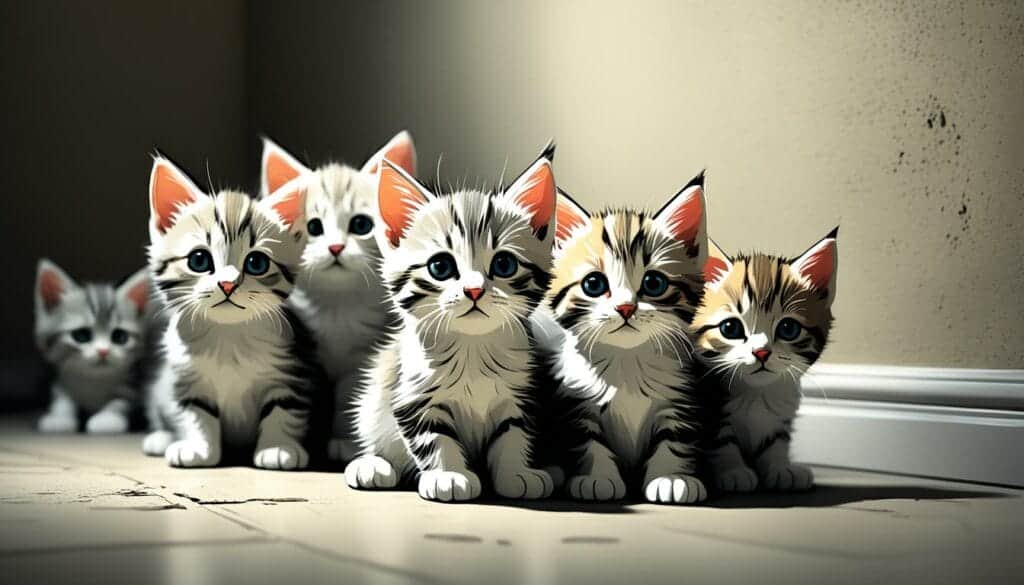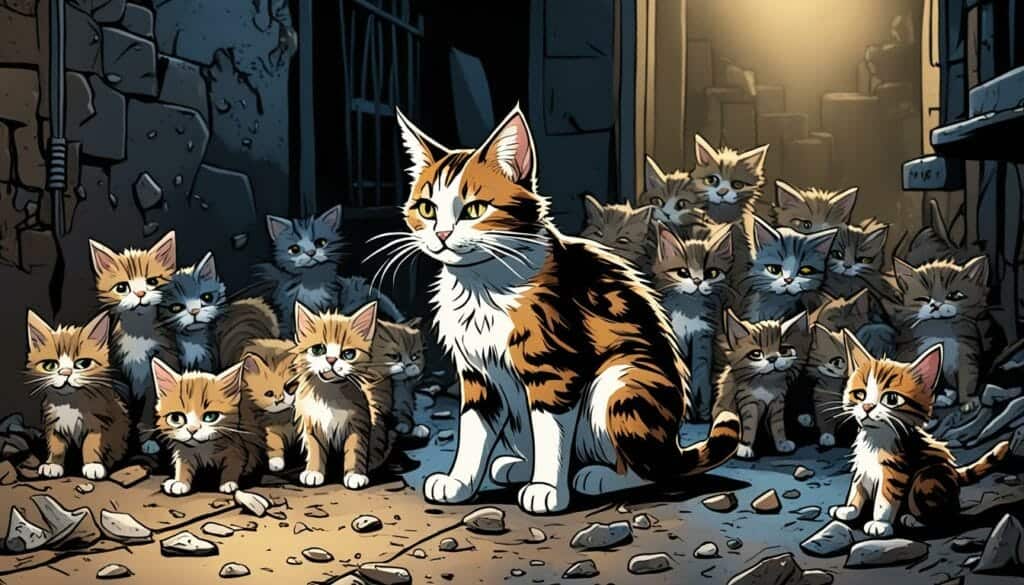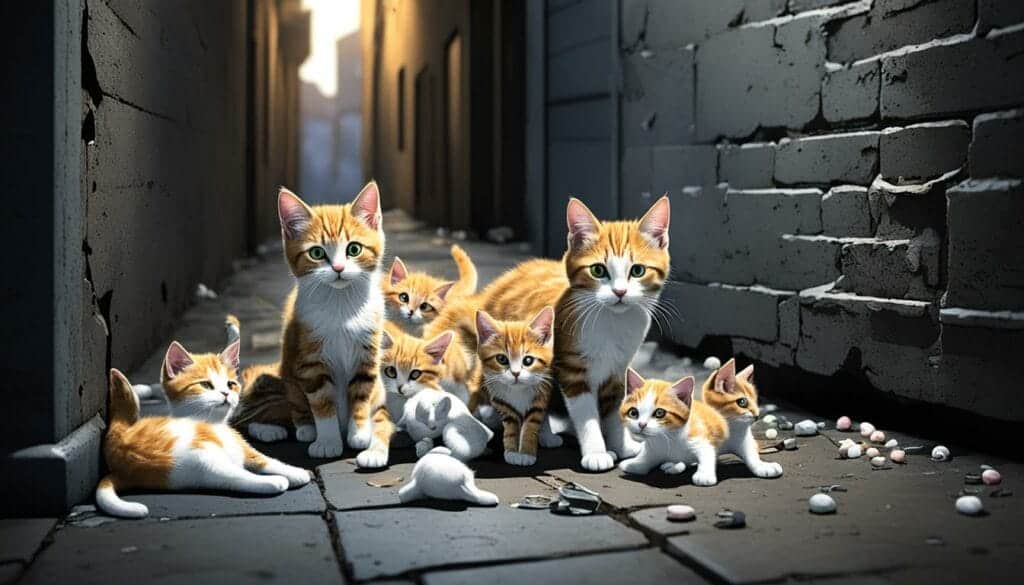
Kitten abandonment, although relatively uncommon, can occur under specific circumstances that challenge a mother cat’s nurturing instincts. Factors such as illness, environmental stressors, or a perceived threat can prompt a queen to leave her kittens. During the crucial early weeks of life, when kittens are most vulnerable, a mother may feel overwhelmed or unable to provide adequate care. This can lead to abandonment, which is often a heartbreaking decision for the cat. Recognizing these potential triggers allows cat owners to create a more secure and calm environment, ultimately supporting the well-being of both the mother cat and her kittens.
When do cats typically abandon their kittens?
Cats may abandon their kittens at various stages of development, though it’s important to note that true abandonment is relatively rare in felines. Here are the three main periods when abandonment might occur:
Immediately after birth
In some cases, a mother cat may abandon her kittens right after giving birth. This can happen for several reasons:
- Stillborn or weak kittens: If a kitten is born dead or extremely weak, the mother may reject it to focus her energy on the healthier offspring.
- Difficult labor: A traumatic or prolonged labor might cause the mother to become disoriented or overly stressed, leading to rejection of the entire litter.
- Lack of maternal instinct: Young or first-time mothers may sometimes lack the instinctual drive to care for their kittens immediately after birth.
- Health issues: If the mother cat is ill or in pain, she may not be able to provide proper care for her newborns.
During the first few weeks of life
Abandonment during this period is less common but can still occur:
- Environmental stress: If the mother cat feels her nesting area is unsafe or frequently disturbed, she may move the kittens or, in extreme cases, abandon them.
- Illness in kittens: If one or more kittens become sick, the mother might reject them to protect the health of the remaining litter.
- Malnutrition: If the mother cat is not getting enough nutrition to produce milk for all her kittens, she may abandon some to ensure the survival of others.
- Human interference: Excessive handling of kittens by humans during this critical bonding period may cause the mother to reject them.
Around weaning time (4-8 weeks)
This is a natural transition period, but sometimes it can lead to what appears to be abandonment:
- Natural weaning process: As kittens become more independent, the mother will gradually spend less time with them. This is normal behavior but may be mistaken for abandonment.
- Preparation for next litter: If the mother becomes pregnant again quickly (which can happen as early as 4 weeks after giving birth), she may begin to distance herself from her current litter.
- Resource scarcity: In outdoor or feral cat populations, if food becomes scarce, the mother may leave her kittens to fend for themselves earlier than usual.
- Social learning: Around this time, kittens need to learn social behaviors from other cats. The mother may introduce them to a larger cat colony, which might appear as abandonment to human observers.
It’s important to remember that what may look like abandonment to human eyes might be normal feline behavior. Mother cats often leave their kittens for short periods to hunt or rest. True abandonment is typically a last resort for a cat and usually indicates a serious problem with either the kittens, the mother, or the environment.

5 Reasons Why Cats Abandon Their Kittens
1. Illness or Physical Defects in Kittens
Cats have a strong instinct to ensure the survival of their genes, which sometimes leads to difficult decisions regarding their offspring. When a kitten is born with a serious illness or physical defect, the mother cat may choose to abandon it to focus her limited resources on the healthier kittens in the litter.
Mother’s Instinct to Focus on Healthy Offspring
This behavior, while seemingly cruel to human observers, is a natural survival mechanism. In the wild, caring for a sick or weak kitten could jeopardize the entire litter’s chances of survival. By concentrating her efforts on the healthier kittens, the mother cat increases the likelihood that at least some of her offspring will survive to adulthood.
Examples of Conditions That May Lead to Abandonment
Kittens may be abandoned due to various health issues or physical defects. These can include congenital disabilities such as cleft palates, which make nursing difficult or impossible. Other conditions like severe respiratory infections, neurological problems, or extreme weakness may also trigger abandonment. In some cases, kittens born with obvious physical deformities or those who fail to thrive despite the mother’s care may be rejected.
2. Maternal Health Issues
The health of the mother cat plays a crucial role in her ability to care for her kittens. When a mother cat is unwell, she may be unable to provide adequate care, leading to the abandonment of some or all of her kittens.
Diseases That Affect the Mother Cat’s Ability to Care for Kittens
Various illnesses can impact a mother cat’s capacity to nurse and care for her young. Mastitis, an infection of the mammary glands, can make nursing painful and reduce milk production. Respiratory infections or more severe diseases like feline leukemia can sap the mother’s strength, making it challenging to meet the demands of motherhood. In extreme cases, these health issues may force the mother to abandon her litter for her own survival.
Malnutrition or Lack of Resources
A malnourished mother cat may not produce enough milk to feed all her kittens. This situation is particularly common in stray or feral cat populations where food is scarce. When faced with insufficient resources, a mother cat may abandon some kittens to ensure the survival of others. This difficult choice allows her to concentrate her limited energy and nutrients on a smaller number of offspring, increasing their chances of survival.
3. Environmental Stress
The environment in which a mother cat raises her kittens can significantly impact her decision to care for or abandon them. Cats are sensitive to their surroundings and require a safe, calm space to nurture their young.
Unsafe or Threatening Surroundings
If a mother cat perceives her environment as dangerous, she may abandon her kittens to protect herself. This can occur in outdoor settings where predators are present or in households with aggressive pets. Construction work, loud noises, or other significant disturbances near the nesting area can also trigger abandonment as the mother seeks a safer location.
Human Interference or Frequent Disturbances
While well-intentioned, human interference can sometimes lead to kitten abandonment. Excessive handling of newborn kittens, constantly checking on the litter, or moving the kittens to a new location can cause stress to the mother cat. If she feels her kittens are being threatened or that she cannot care for them safely, she may choose to abandon them.
4. Inexperience or Young Age of the Mother Cat
Young or first-time mother cats may struggle with the responsibilities of motherhood, sometimes resulting in the abandonment of their kittens.
First-time Mothers May Lack Maternal Instincts
Maternal behavior in cats is partly instinctual and partly learned. Very young mothers or those who were separated from their own mothers too early may not have fully developed maternal instincts. This can lead to confusion or uncertainty about how to care for their kittens, potentially resulting in neglect or abandonment.
Overwhelmed by the Demands of Motherhood
Caring for a litter of kittens is a full-time job that requires significant energy and attention. Inexperienced mothers may become overwhelmed by the constant demands of nursing, cleaning, and protecting their kittens. This stress can sometimes lead to the mother rejecting one or more kittens as she struggles to cope with her new responsibilities.
5. Large Litter Size
While cats are generally capable of caring for multiple kittens, an unusually large litter can present challenges that may lead to abandonment.
Insufficient Milk Supply for All Kittens
A mother cat’s body can only produce a limited amount of milk. In cases of very large litters, there may not be enough milk to adequately nourish all the kittens. This situation can force the mother to make the difficult choice of abandoning some kittens to ensure the survival of others.
Mother’s Instinct to Focus on Strongest Kittens
When faced with a large litter and limited resources, a mother cat may instinctively focus her attention on the strongest and most viable kittens. This behavior, known as triage, is a survival mechanism that aims to ensure at least some of the offspring survive to carry on the mother’s genes. Unfortunately, this can result in the abandonment or neglect of smaller or weaker kittens in the litter.
Age at Which Cats Abandon Their Kittens
Mother cats usually abandon their kittens when they are around 4 weeks old. At this age, the kittens are considered old enough to fend for themselves, reducing the strain on the mother cat.
If the mother cat continues to care for the kittens beyond this age, she may end up with numerous offspring that can consume her energy and resources. Therefore, it is a natural behavior for mother cats to abandon their kittens at this stage.
Age of Kittens (weeks) |
Mother Cat’s Behavior |
|---|---|
| 0-2 | The mother cat constantly nurses, cleans, and protects the kittens. |
| 3-4 | The mother cat begins to wean the kittens and encourages them to eat solid food. |
| 4+ | The mother cat gradually distances herself from the kittens, allowing them to become more independent. |
During the period when the mother cat starts abandoning her kittens, it is essential to ensure their well-being, as they are still developing and learning important social and survival skills. Providing a safe environment, nutritious food, and monitoring the kittens’ health is crucial during this transition period.
Additionally, it’s important to remember that each mother cat and litter of kittens may behave differently. While many mother cats may gradually abandon their kittens around 4 weeks of age, some may continue to care for them for a longer period. Observation of the mother cat’s behavior and addressing any concerns promptly will help ensure the best outcome for both the mother and her kittens.
Immediate Risks to Abandoned Kittens
When kittens are abandoned, they face significant and immediate risks to their health and survival. Newborn and very young kittens are completely dependent on their mother for warmth, nutrition, and care. Without their mother, abandoned kittens quickly become dehydrated, malnourished, and unable to regulate their body temperature. This puts them at high risk of illness and death within a matter of hours or days if they do not receive proper care.
Natural Outcomes in the Wild
In a natural outdoor setting, the outlook for abandoned kittens is often grim:
Increased Mortality Risk
Abandoned kittens in the wild face an extremely high mortality rate. Without their mother’s protection, warmth, and nourishment, most will not survive more than 24-48 hours. They are vulnerable to predators, exposure to the elements, starvation, and disease.
Potential Adoption by Other Cats
In rare cases, another nursing mother cat may come across abandoned kittens and adopt them into her own litter. However, this is uncommon, especially for very young kittens that require intensive care.
Human Intervention and Care
When humans discover abandoned kittens, there is potential for a more positive outcome:
Rescue and Hand-Rearing
With proper intervention, abandoned kittens can be rescued and hand-reared by experienced caregivers or veterinarians. This involves:
- Providing warmth through heating pads or incubators
- Bottle-feeding with kitten milk replacer formula every 2-4 hours
- Stimulating elimination by gently wiping their genital area
- Offering constant care and monitoring
Importance of Proper Care and Feeding
Caring for abandoned kittens is an intensive process requiring around-the-clock attention. Proper nutrition, warmth, and hygiene are critical for giving abandoned kittens a chance at survival. Even with the best care, hand-reared kittens have a higher mortality rate than those raised by their mothers.
Long-Term Effects on Development
Kittens that survive abandonment may face some developmental challenges:
Social and Behavioral Impacts
Orphaned kittens miss out on important socialization from their mother and littermates. This can lead to behavioral issues later in life, such as:
- Increased fearfulness or aggression towards people and other cats
- Poor learning and social skills
- Deficient parenting skills if they become parents themselves
Physical Development
While dedicated human care can help abandoned kittens survive, they may still experience some physical developmental delays or health issues compared to mother-raised kittens. Proper veterinary care and nutrition are essential to support their growth and development.
While abandonment poses severe risks to kittens, timely human intervention and proper care can give them a chance at survival and a healthy life. However, prevention through responsible pet ownership and support for local animal welfare organizations remains the best approach to addressing the issue of abandoned kittens.

How to Minimize Kitten Abandonment
Education and Awareness
One of the most effective ways to minimize kitten abandonment is through education and raising awareness about responsible pet ownership. Many cases of abandonment stem from a lack of understanding about the commitment required to care for a kitten. Public campaigns, school programs, and community outreach initiatives can help inform people about the realities of pet ownership, including the time, cost, and effort involved in raising a kitten. These programs should emphasize the importance of spaying and neutering to prevent unwanted litters, as well as the long-term commitment required when adopting a pet.
Promote Spaying and Neutering
Encouraging and facilitating spaying and neutering is crucial in reducing the number of unwanted kittens. Organizations can offer low-cost or free spay/neuter services to make these procedures more accessible to pet owners. Additionally, implementing trap-neuter-return (TNR) programs for feral cat populations can help control the number of stray kittens born in communities. These efforts not only prevent unwanted litters but also contribute to the overall health and well-being of cats in the community.
Support for New Pet Owners
Providing support systems for new kitten owners can significantly reduce the likelihood of abandonment. This can include:
- Offering post-adoption counseling services
- Providing access to affordable veterinary care
- Creating helplines or online resources for pet care advice
- Organizing support groups or classes for new pet owners
By giving new owners the tools and knowledge they need to care for their kittens properly, many of the challenges that lead to abandonment can be addressed early on.
Improve Adoption Processes
Shelters and rescue organizations can play a crucial role in minimizing abandonment by improving their adoption processes. This includes:
- Conducting thorough interviews with potential adopters to ensure they understand the commitment
- Providing detailed information about the kitten’s personality, needs, and any known health issues
- Offering a trial period for adoptions to ensure a good fit between the kitten and its new family
- Following up with adopters after the adoption to address any concerns or issues
By carefully matching kittens with suitable homes and providing ongoing support, the likelihood of successful, long-term adoptions increases.
Address Root Causes
To truly minimize kitten abandonment, it’s essential to address the root causes that lead to this problem. This may involve:
- Tackling poverty and financial instability, which can make it difficult for some people to care for pets
- Improving access to pet-friendly housing options
- Addressing cultural attitudes towards pets and animal welfare
- Developing community support systems for pet owners facing temporary hardships
By working on these broader societal issues, we can create an environment where fewer people feel compelled to abandon their kittens.
Strengthen Animal Welfare Laws
Finally, strengthening and enforcing animal welfare laws can serve as a deterrent to kitten abandonment. This includes:
- Implementing stricter penalties for animal abandonment
- Requiring microchipping of pets to improve owner accountability
- Enforcing mandatory spay/neuter laws in certain areas
- Regulating breeding practices to reduce the number of unwanted kittens
While laws alone cannot solve the problem, they can play an important role in changing societal attitudes and behaviors towards pet ownership and abandonment.
By implementing these strategies comprehensively, communities can work towards minimizing kitten abandonment and creating a more responsible and compassionate environment for all pets.
Takeaways
The issue of kitten abandonment is complex and multifaceted, involving various factors that contribute to this unfortunate phenomenon. By implementing these strategies and fostering a culture of compassion and responsibility towards pets, we can work towards minimizing kitten abandonment and ensuring better outcomes for both cats and their offspring.
Remember, if you encounter what appears to be abandoned kittens, it’s essential to assess the situation carefully before intervening. In many cases, the mother may simply be away temporarily.
However, if intervention is necessary, seek guidance from local animal welfare organizations or veterinarians to ensure the best possible care for the kittens.
Addressing kitten abandonment requires a collective effort from pet owners, animal welfare organizations, and communities at large. So let’s do our part in minimizing kitten abandonment. 💪🏼


In her previous life, Lisa traveled extensively, both for work and leisure. After the pandemic struck, Lisa locked up her luggage and adopted a cat ever since.
Lisa is now an avid cat lover, she devotes most of her free time serving as butler to her adorable feline at home. When she is not with her cat, she can be seen using her phone sourcing for the latest cat supplies online.


